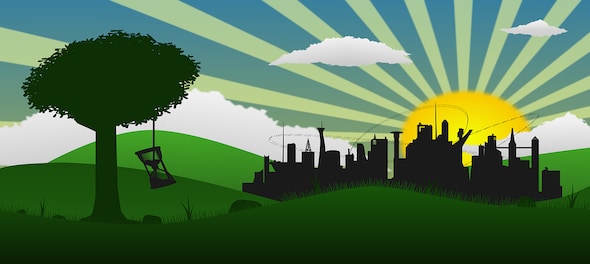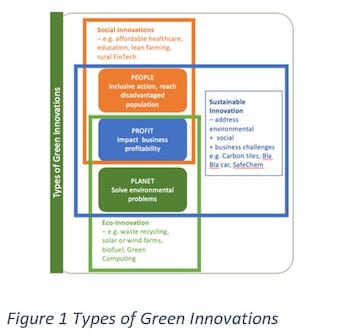
There is a new trend underfoot in the world of Green and Sustainable solutions. That of innovations creating Win-Win Solutions to meet human needs, to help businesses earn a healthy profit and to support the global effort in keeping the Earth Green. Such Innovations are called Sustainable Innovations or SI.
There are numerous examples—Bla Bla Car—an app that allows ride-sharing by regular people—saving fuel, allowing commuters to share fuel costs and creating social bonds. Carbon Craft Design, Mumbai converts carbon from air pollution into tiles. Traditional craftspeople in Tamil Nadu and Gujarat handcraft these tiles and the manufacturing process consumes only one-fifth of the energy required to manufacture vitrified tiles. The tiles are cheaper than the alternatives available in the market. Qarnot Computing reuses waste heat from computing in homes. Distributed computing sends calculations to home-based servers that heat up households for free.
Problems, Perspectives and Priorities
It is heartening to see that the push for innovation in the last two decades has led to a paradigm shift—businesses are no longer seen as the problem or “Polluters” but are now an integral part of “Green” solutions. These green solutions or sustainable innovations allow businesses to go several steps beyond Corporate Social Responsibility and reporting on the Triple Bottom Line.
So far, many businesses have found it difficult to “go-green” because products like electric cars, solar panels or organic clothing have been expensive and consumer adoption rates painfully low. As a possible solution—the new generation of green entrepreneurs and business leaders are open to an evolved thinking approach where the environment, people and profit come together. EU and various other agencies have facilitated the change—encouraging businesses to build and test innovations that address environmental issues. A majority of innovations—whether product or services —pay attention to sustainability, especially on how to lower environmental impact, improve community engagement and ensure business success.
Making Sustainable Innovation Work!
Like any innovation process, SI is an exercise in combining “problem-solving” and “decision making”. The difference is with the type of problems that are addressed (social and environmental issues), the way the solutions are created (outside the box) and which choices are given priority (profit vs people or “profit and people”).
Amongst the green innovations available in our world today, Sustainable Innovation attempts to embrace both eco-innovation (profit+planet) and social innovation (people+profit). Where eco-innovations mainly look at creating products that solve environmental challenges (see Figure 1 below), a Sustainable Innovation like “Carbon Tiles” attempt to create a profitable business that addresses environmental issues (air pollution) and create social equity—(employing traditional craftsmen and generating local employment).

Amongst the diverse and insightful literature available about SI all around the world, one can easily see four themes:
1. Innovation that works towards SDGs
Katerva, a leading international repository of SI examples defines “Sustainable innovation is a process where sustainability considerations (environmental, social, financial) are integrated into company systems from idea generation through to research and development (R&D) and commercialization…” The 17 Sustainable Development Goals (see Figure below) by UN are a good place to start looking for inspiration—if you want to create an impact with your business.

2. Solve ‘Wicked’ problems and Build to Scale
Many of us would agree that slow, creeping change will take too long to meet todays’ challenges of “Wicked Problems”—problems that are ill-defined, widespread and complex. Sustainable Innovation can be a critical solution to these issues that impact thousands if not millions—poverty, hunger and well-being. The innovations must be radical or disruptive enough to ensure lasting High Impact change that can be readily scaled.
3. Passionate Entrepreneurs and Strong Business Models
The real force behind any SI are the Entrepreneurs who are willing to question norms, build enterprises on robust business models, ally with multi-disciplinary teams to rebuild supply chains and ensure that they turn a reasonable profit to ensure financial self-sufficiency. The need of the hour is system-level Impact with scalable and replicable business models.
More often than not, such innovations are technology-driven. Example—FIA Technologies that is taking technology-based financial solutions to rural India and Nepal. They have taken up the challenge of Delivery of Rural Financial Services—over 8 years, they have reached 30 million customers and employed 25,000 rural youth.
4. Engaged Stakeholders & Integrated Ecosystems
Any change at this level requires a strong alignment with stakeholders. Without buy-in and consensus from key parties, moving forward on large-scale projects is not possible. Stakeholders can be internal (employees), connected (vendors, supplier) and external (local community, NGOs, public institutions). constant learning and knowledge sharing are integral to building a holistic approach. To understand the customer’s perspective, designers also use Empathy Maps.
Obstacles as Opportunities
Daily, we are faced with complex, far-reaching technologies that are mutating our daily lives. The practical reality of the post-Corona lockdown phase is that many businesses are being forced to adapt and evolve at a faster than normal rate. The time is ripe to seek solutions that balance social and environmental challenges with a business’s raison d'être—to earn a profit. Otherwise, we will be left with piles of discarded PPEs and plastic face shields, poor migrants with no access to work, and a world vary of taking risks.
—Anubhuti Gupta is an independent expert in Learning and Development. She has a Masters2 in Eco-Innovation from Université Paris-Saclay, France. The views expressed are personal
Check out our in-depth Market Coverage, Business News & get real-time Stock Market Updates on CNBC-TV18. Also, Watch our channels CNBC-TV18, CNBC Awaaz and CNBC Bajar Live on-the-go!


Lok Sabha elections 2024: Seats to date, all you need to know about third phase of voting
May 6, 2024 4:49 PM
Concerns on low voter turnout a "myth"; absolute number of voters correct way to analyse: Report
May 6, 2024 2:57 PM
Haryana Lok Sabha elections 2024: A look at JJP candidates
May 6, 2024 2:26 PM
Yadav family members in focus in third phase of Lok Sabha polls in Uttar Pradesh
May 6, 2024 12:59 PM

